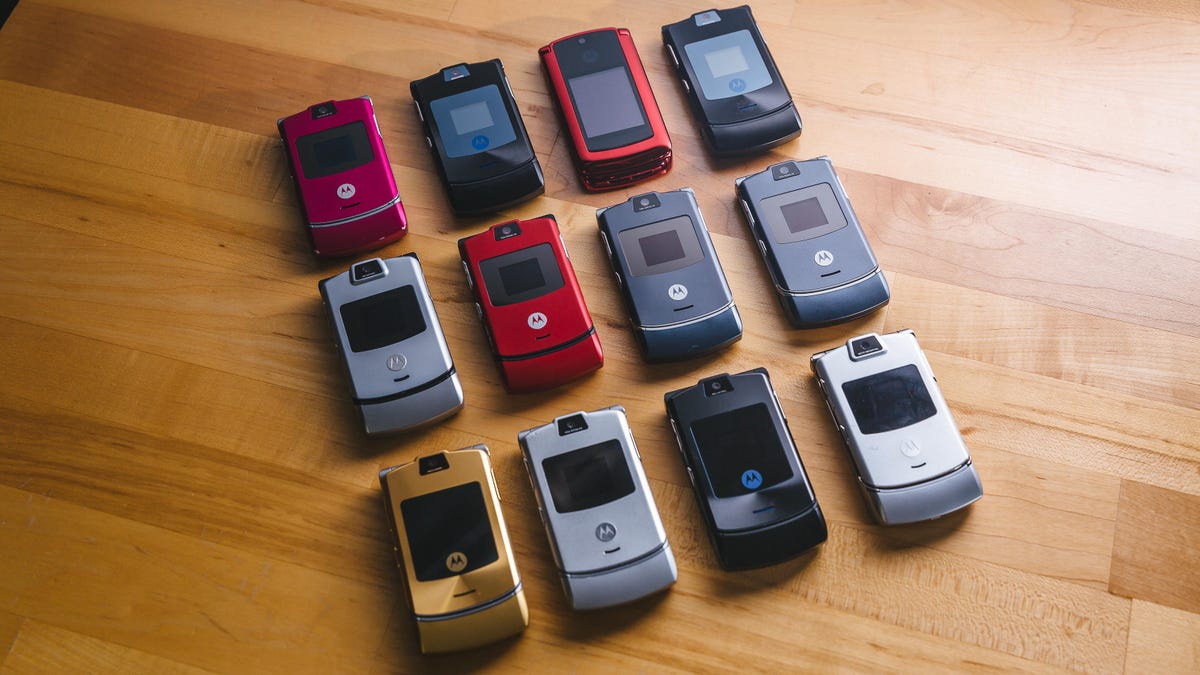I was wrong about the first Razr
Long before the iPhone or the Galaxy line, the thin Motorola phone was all the rage. And I failed to see just how popular the Razr would be.

There was a Razr for everyone.
After more than 16 years reviewing several hundred phones for CNET, only a handful burn brightly in my memory. Mobiles like the first iPhone, the Nexus One and the Motorola Razr V3 will forever rise above a churning sea of black rectangles that have blended into each other.
My relationship with the Razr is particularly complicated. I remember it not just because of its groundbreaking ly slim profile, but also because I was initially so wrong about it. Years from now, when I'm annoying my nephew to help me use the whatever phone has been invented by then, I will admit that I didn't foresee the thin phone tsunami that followed the Motorola Razr's release.
Now Motorola is trying to replicate that success by unveiling a new Razr in a foldable design. CNET's Jessica Dolcourt went hands-on with the phone and Roger Cheng has its creation story, but first join me for my Motorola Mea culpa.
Like I said, I was wrong
Motorola's Razr press release first landed in my inbox in early July 2004, a few days after then-CEO Ed Zander displayed the handset during an investor's conference (few companies announced phones at flashy launch events in those days). My immediate thought was, "It's thin... so what?" It didn't promise any new features and the photos in the press release made it look far from impressive. It looked like a coaster and I was concerned it would feel like a toy.
So, after writing a quick First Take with my first, not-so-cogent analysis ("Eh, it looks OK"), the Razr quickly slipped from my mind. I wouldn't be able to review it for a couple of months, and this was a time when Nokia was in its heyday, introducing a new phone seemingly every week. They all needed a review, not to mention the regular series of phones from Nextel, Sanyo and other manufacturers that have long since left the business.
A couple of months later, the Razr finally went on sale at Cingular Wireless (now AT&T ). Though I just tried to convince a gadget-obsessed friend that the Razr would not be worthy of the hype that had begun to build around it, the queues that quickly formed at Cingular stories were the first sign that I was mistaken.
A daring design
My review model finally arrived in late November and it was then, when I held the Razr in my hand, that I really grasped just what Motorola and designer Paul Pierce had done. Moto was well on its way to changing the phone world. Again.
Motorola had been making history since Martin Cooper placed the first public cellphone call in 1973. Moto then built the world's first commercially available phone, the first mainstream flip phone and the first 3G phone sold in the US. But while Moto's previous hits had at least one envelope-pushing feature (even the Startac was one of the first phones with a vibrate mode), the Razr's feature highlights were a VGA camera (equivalent to 0.3-megapixel), Bluetooth and voice dialing -- generous for the time, but hardly noteworthy.
The new foldable Razr is even more striking than its predecessor.
Outside, though, the Razr was an entirely different story. Motorola had achieved a rarity in the gadget world: a design we'd never seen before. The Razr was gorgeously thin (just half of an inch wide), it had a shiny metal skin and it didn't feel flimsy or cheap. Yes, it was boxy and the buttons were slippery, but it looked so damn good and it slid effortlessly into your pocket. Try doing that with the latest Samsung Galaxy Note.
Motorola's success was even more impressive when you remember that 2004 was a time when phone design was massively more exciting and varied than it is now. We had flip phones, swivel phones and sliders. Almost every phone -- especially the crazy designs from Nokia -- looked different. The placement of physical buttons and the shape of the body really mattered. Until we get a real bendable phone, phone design will remain relatively dull.
In my final review, I gave the Razr three and a half stars and said, "More than just a pretty face, the Razr V3 backs up its radical design with solid features and good performance." (I pooh-poohed the lack of video recording and the call volume level.) In the end, I got it right.
See also
- Motorola's new foldable Razr phone is compelling. Here's why
- Inside Motorola Razr's foldable makeover
- Motorola's Razr is a Verizon lifetime exclusive
- See all of our Motorola Razr coverage
Making thin in
Of course you know the rest of the story. Despite an initial price of $450 with service (about $725 adjusted for inflation), the Razr was an instant hit. My friend, and many like him, waited hours to get one and Cingular stores sold out. Motorola's competitors quickly noticed, and the thin phone revolution had begun. It was a revolution that lasted a bit too long -- it took the iPhone 's introduction in 2007 to really kill it -- and Motorola produced too many Razr versions in a rainbow of colors (plus a few Krzrs, Slvrs and Rizrs). But it all showed the power that one phone could have.
So, yes, I did not call this one well. As it turned out, a new design could be enough to make a phone popular. And while we stay mired in an era where every phone looks the same, I'll fondly remember a time when that kind of revolution was possible.
Originally published Dec. 22, 2018.
Update, Nov. 13: Adds information for the new foldable Razr launch.

